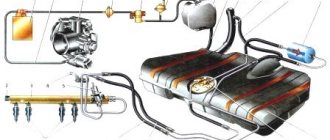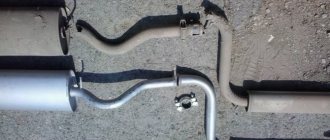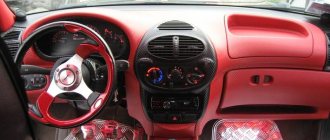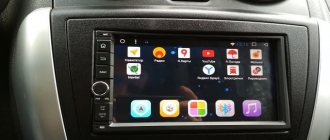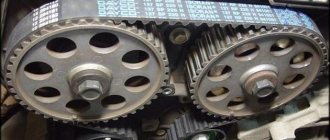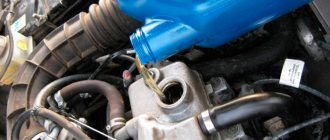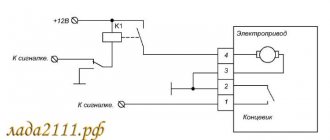How it works
A modern car climate control system includes the following main components and mechanisms:
- air conditioner – helps cope with excessively high temperature and humidity;
- car heater - heat is taken from the heated engine coolant;
- fan – provides air mixing inside the cabin;
- system of air ducts and intakes - makes it possible to distribute air flows and direct them to the required point in the cabin;
- air intake curtains are driven by electric servo drives;
- electric stove valves - cut off the heat exchanger when there is no need for heat;
- thermal sensors – measure the air temperature at different points in the cabin;
- humidity sensor - not used in older models;
- software controller - analyzes sensor data and gives commands to turn on actuators.
Air conditioning system operation diagram
The operating principle of climate control in a car in winter is as follows:
- the driver sets the required temperature in the cabin, for example, 23 degrees;
- the installation is switched to “auto” mode;
- the controller analyzes data from temperature sensors and compares it with the task;
- if the temperature in the cabin is higher than the set one, then the air conditioner turns on (in winter this is practically impossible);
- if the temperature is lower than the set one, then the electric valves of the heater open, antifreeze is supplied to the radiator from the engine cooling system;
- Based on the difference between the actual temperature and the set one, the controller gives a command to turn on the required fan speed, taking into account the degree of heating of the coolant in the stove;
- if necessary, the “Recirculation” mode is automatically activated;
- When the set temperature is reached, the controller reduces the blowing speed and switches the system to maintenance mode.
Four-zone climate control
Interior ventilation
To ventilate the interior, set the ventilation and heating control unit controls to the following positions.
- Turn control knob 2 to the minimum temperature position (see Fig. 1 and 2).
- Place the regulator handle 4 opposite the pictogram.
- Open the nozzles on the instrument panel.
- Set the desired air supply speed with switch 1.
- If the windshield fogs up, set the regulator handle 4 opposite the pictogram.
Features of operation in winter
The climate control algorithm described above is quite general. Each manufacturer develops a climate system for a specific model or series. The controller software may also differ slightly. The latest versions of electronic climate control allow the car owner to independently program some of the installation functions. The operation of climate control in a car in winter sometimes requires intervention and switching to manual control:
- The car was in an open parking lot and its windows were covered with ice. To start moving, you need to quickly clear the viewing areas from ice. Not all climate control firmwares provide for automatic pre-heating of the windows. There may be a situation where the program provides such a function, but the specified heating time was not enough. In this case, you have to exit the automatic mode and manually turn on the glass defrost. You will also have to choose the fan speed. Once the icing is cleared, you can return to automatic settings.
Controlling the climate system of a Lada Granta car
In 2014, the domestic AvtoVAZ plant presented to its fans another modified version of the Lada Grant. Well-equipped, containing almost the entire list of modern equipment for which famous Western and Eastern models are famous, this car won the hearts of a multimillion-dollar audience and today has become one of the top three leaders on the Russian market. One of the advantages of the Lada Granta model is a good climate system, which only five to seven years ago manufacturers and drivers could only dream of. What is the climate system of the Lada Granta, what are its design features, pros and cons, possible breakdowns?
Humidity reduction function
Almost everyone knows that an air conditioner, while working to cool, dries the air. Not many people have heard how climate control in a car copes with this task in winter. To ensure this function, the installation is equipped with a special humidity meter. Data from this sensor is sent to the controller. At low negative temperatures, air dehumidification is usually not required; the stove can handle moisture vapor. The situation changes at temperatures close to zero, in conditions of wet snow, and during a thaw. The car windows begin to fog up intensely. In this situation, your climate control system will operate as follows:
- the humidity sensor will inform the controller about the need to remove excess moisture;
- the controller will give a command to turn on the air conditioner and stove simultaneously;
- moist air passing through the air conditioner evaporator will leave moisture particles in the form of condensation or frost on the heat exchanger honeycombs;
- After the evaporator, the air enters the stove radiator, where it is also further dried.
Thus, the use of climate control prevents the windows from fogging up and provides comfortable driving conditions in winter.
Cabin filter
Filter
Before using climate control in your car in winter, carefully read the car's operating instructions. In it you will probably find recommendations for replacing the cabin filter. This air purification element plays a very important role for the operation of the air conditioning system. If the filter is clogged with dust, then heating and drying will be ineffective - the windows will fog up, and the interior will heat up more slowly. Manufacturers offer three options for filter elements:
- paper - the easiest and cheapest cleaning method;
- coal - act much more efficiently;
- antibacterial - prevent the proliferation of pathogenic organisms in the air ducts of the car's air conditioning system.
It is recommended to replace the cabin filter twice a year. In some cases, the procedure will have to be performed more often - for example, when driving on dirt roads.
1200 rub. for the photo report
We pay for photo reports on car repairs. Earnings from 10,000 rubles/month.
Write:
The climate control system in the car provides comfort and convenience for the driver and passengers. Its main difference from an air conditioner is that it constantly maintains the specified climatic conditions. The system can be single- or multi-zone. Due to its complexity during operation, car owners may have a number of questions, in particular: “How to use the climate control? What to do if the climate control does not turn on ? How to clean climate control ? We will try to talk about this and much more in detail.
What is climate control in a car?
Automotive climate control (hereinafter referred to as CC) is a system consisting of an air conditioner, a heater, temperature and humidity sensors, a filtration system and an electronic control unit. The purpose of the system is to maintain the microclimate inside the car, regardless of the weather outside.
The operating principle of climate control is simple. It is based on the operation of an electronic feedback processor, which receives information from numerous sensors that record the temperature in different parts of the car interior. The user sets the desired temperature parameters in the control unit. And the processor supports them all the time, based on information from the sensors, and, if necessary, adjusting the operation of the cooling or heating systems.
Interestingly, the climate control includes not only an air conditioner, but also a heater. Therefore, the system can also be used in winter to heat the interior. In addition, the air conditioner and heater dry the air passing through them. This makes it possible to prevent car windows from fogging up . In more advanced systems, the processor also takes into account the effect of sunlight on the interior temperature (the so-called ultraviolet sensor).
Another feature of car climate control is the ability to recirculate air in the car if the outside air is too polluted. This is ensured by monitoring the filtration system. If the degree of air pollution exceeds the permissible norm, then the climate control does not take air from outside, but repeatedly rotates the air volume located in the car’s cabin. As a rule, this happens automatically.
Evgeny161 › Blog › Installing an air conditioner in a grant
Have a good day everyone!
I would like to share with you a post about installing the original Halla-visteon factory air conditioner (NOT AUGUST OR FROST) in GRANTA.
As it usually happens, either here on the drive, or on VKontakte in my group avtoklimat161, or in the advertisements on Avito, the owner of this grant found me...
The car is like a car and there is no air conditioner... Having told the owner about the options for installing new or used equipment, about the cost (new turnkey 50, used - 35), we agreed that we will install used equipment, especially since this year I have thoroughly stocked up on such equipment, because I think that new ones are sooooo expensive, but used ones, during pre-sale preparation, are no different in either quality or operational efficiency!
In my opinion, the Granta is best suited to be equipped with air conditioning. The installation process is not particularly complicated, a standard “locksmith” - unscrewed - removed - took another - installed - screwed.
But there are things with which there are problems with grants!
1. On cars without air conditioner there is NO belt tensioner mechanism! That is, you need to buy a Kalinovsky generator bracket with an adjusting screw and a roller.
2. The most important thing is that on grants, depending on the ECU model and firmware, you must use either a THREE-CONTACT coolant pressure sensor or a FOUR-PIN! And they are not interchangeable! Apparently, this is why FROST kits do not have a connection to the computer, so as not to worry about what firmware is there and what unit is there. And this is categorically NOT CORRECT! ! THE ECU SHOULD KNOW THAT THE AIR CONDITIONING IS ON. MOREover, IT IS THE ECU THAT TURNES ON THE MAIN FAN AND COMPRESSOR AND CORRECTS THE IDLE SPEED, AND ALSO TURN OFF THE COMPRESSOR WHEN SHARPLY PRESSING THE GAS PEDAL, THUS MAKING IT EASIER FOR THE ENGINE TO GET RPM SHARPLY - IT HELPS VERY WHEN OVERTAKING ESPECIALLY ON TRAIN.
Types of climate control and their features
Climate control systems are divided according to different criteria - the presence of separate work zones, power, ease of control, and the presence of additional functions. First, let's talk about single- and multi-zone systems.
Operation of a multi-zone QC system
Today, single-zone, dual-zone, three-zone and four-zone climate controls . What is it and how are they different? Single-zone climate control is the simplest of the systems presented. It is designed according to the principle described above and controls the air parameters in the driver and front passenger area. Dual-zone climate control divides the air space between the driver and front passenger, respectively, into two parts, for which different climate parameters can be set. This provides additional convenience. Three- and four-zone systems also allow you to set individual climate parameters for rear passengers. The last option is considered the most advanced and comfortable.
Now a few words about the differences between climate control systems and the car air conditioning that is familiar today. Let's start with the last one. It performs two functions - it cools the air and dehumidifies it. That is, this device has no feedback. The driver must independently regulate the temperature supplied by the air conditioner in real time. And this is not always convenient. The main difference between climate control is precisely the presence of feedback, which is needed to maintain user-specified parameters on an ongoing basis.
Climate control system design
Climate control consists of a large number of devices. In particular:
- Electronic control unit . This is perhaps the most important part of the system, its “brain”. It includes a controller with control programs and an information input system. These can be mechanical or electronic regulators. As a rule, information is entered into modern control units digitally, including using a remote control. Based on the incoming information, the controller program controls the executable devices - the fan rotation speed, the position of the dampers, and issues a command to increase or decrease the temperature of the blown air.
- Sensors _ They are located both inside the car and on the outside. Internal sensors monitor climate indicators in the areas where they are installed. There is also a separate temperature control sensor at the heater/cooler outlet. Interior sensors usually have forced airflow so that they provide information as quickly as possible. The more complex the system (multi-zone), the greater their number. External sensors are designed to monitor the temperature and air pollution outside the vehicle.
- Actuators . There are many devices that fall into this category. In particular, cooling and heating devices (air conditioner and stove), air dampers and their drive motors, air ducts, fans, filters, deflectors, and so on.
Components of the climate control system
It is not at all necessary for the driver to thoroughly know the internal workings of climate control. It is much more important to know the symbols on the climate control control knobs and how to configure the parameters. And also understand what preventive measures to take in order to keep the system in working order.
Evaporator check
The evaporator is located inside the car, it is located under the panel, and therefore it is very difficult to get to it. If it is heavily soiled, an unpleasant odor begins to spread in the cabin after turning on the air conditioning system. The car owner can clean the evaporator with his own hands; in addition, service stations also provide similar services.
Removing the radiator cooling fan on the Lada GrantaTypes of armrests for the Lada GrantaInstalling speakers in the rear doors on the Lada GrantaDynamic characteristics of the Lada Granta with a VAZ 21126 engine on the mechanicsBrake pedal sensor on the Lada GrantaElectrical circuit diagrams of the Lada Granta
- On-board computer STATE x1-g for Lada Granta
Granta's climate system includes ventilation and heating of the vehicle. Air masses are supplied to the Lada through the air intake through the use of a special fan driven by an electric motor. Air purification is carried out using a filter.
Return to contents
How to use climate control
Different vehicles may use different controls to operate the climate control. But as a rule, the designations on them are standardized. Below we provide up-to-date information.
Review of dual-zone CC control on a Ford Focus 3
How to turn on climate control? Typically, a button with the words ON/OFF or an image of a broken circle is used for this. To turn on the air conditioner, use the button labeled A/C. The temperature in the general or separately in each zone is set using buttons or a rotary controller (roller). As a rule, the adjustment step is 0.5°C. The maximum difference between individual zones is 4.5°C. The AUTO button allows you to directly activate the system so that it automatically maintains the set temperature.
Also, in any climate control unit there are several buttons that indicate the direction of air movement. The minimum number is three. This is blowing the legs, blowing the head and legs, and blowing the windshield. Often there are more modes.
The CC control algorithm is basically the same for everyone; it all comes down to setting the required temperature with a knob or buttons and setting the blowing area. But still, different cars may have their own nuances, so it is better to find how to use climate control in the manual for your car or directly in the climate control operating instructions.
It is recommended to check the refrigerant system for leaks at least once a year. If necessary, refrigerant is added to the system. This needs to be done in a special service. It is also advisable to do diagnostics of the electronic unit there.
An example of button designations on the climate control control panel in Volkswagen cars
One more tip. The climate control system (like the air conditioner) must be turned on no earlier than one minute after starting the engine . And at the end of the trip it’s the other way around. Turn off the air conditioner at least one minute before stopping the engine.
Components of an air conditioner
The thermostatic valve is located in the evaporator housing and is designed to reduce pressure. This phenomenon causes the refrigerant to boil in the evaporator. It should be noted that the device does not require configuration.
As for the receiver-dryer, this unit is used for liquefied refrigerant purification. Filtration is carried out using silica gel. Long-term depressurization of the air conditioning system requires replacement of the device. This is due to the fact that the dehumidifier in the Frost model, after refueling the system, is not able to fully perform its functions. The result can be the formation of acids and their destruction inside the air conditioning system.
The components of the structure under consideration are connected to each other by a pipeline. This product is made of aluminum alloy and has a single sealed circuit. During the operation of the vehicle, it is recommended to avoid possible dents or scratches on this pipeline. The moving elements of the air conditioner are connected to each other by special flexible inserts made of synthetic raw materials. These inserts can withstand pressures up to 30 bar. Each rubber pipeline connection is equipped with rings that are designed to improve sealing. It should be noted that these rings are disposable, so they require replacement when dismantling or disconnecting pipelines and inserts.
Return to contents
Installation of climate control
Some car owners whose cars are not equipped with a climate control system decide to install it additionally. This task requires spending a lot of time, money and effort. In addition, you need to know that the QC system may not be installed on every machine. After all, the fact is that the stove must be of a certain design so that it is possible to install various servos and wiring under the “dashboard”.
But if you still decide to install an additional climate control system on your own or with the help of specialists, then you will need the following list of devices and assemblies (may differ for different cars):
- electrical wiring from a similar car that has a climate control system (this is a whole wiring harness);
- a stove that was installed on a similar machine with a CC system, and working servos must be attached to it;
- two temperature sensors installed in the stove pipe;
- two temperature sensors installed in the central air ducts;
- solar radiation sensor (may not be part of the CC system);
- fan sensor with a cover-mount (the cover is usually very difficult to find); frame;
- control unit (the only element that is widely available).
Often, when installing a system, it is necessary to change the factory “torpedo” of the car. For this, different methods and materials are used. For example, fiberglass, from which additional elements are made for attaching CC controls. Work must be performed carefully so as not to damage factory elements.
The stove doesn't heat well
Car owners begin to notice that the stove is not heating well only with the arrival of cold weather, although the reasons for poor performance arise much earlier. Most often, the stove in a car heats poorly due to: airing, a faulty pump, a clogged radiator and cabin filter Read more
Car heater and care
A car heater is a heater radiator with the entire system as a whole. Periodic maintenance is required for proper functioning. The list of required work includes: checking, cleaning and replacing the cabin filter Read more
Diagnostics, repair and refilling of car air conditioning
A visual guide to car air conditioning maintenance and repair will help you properly maintain your car's air conditioner. Diagnostics are carried out not only when refilling freon, but also every seasonal maintenance.
Reviews
| № | Positive |
| 1. | Vladimir: Six months have passed since we bought the car, and there have been no breakdowns in such a short time. The fan refused to start several times, the reason turned out to be a bad fuse contact. |
| 2. | Vasily: I have been actively using the machine for two years, there are no particular complaints, all units are working as normal. Breakdowns happen, like everyone else, but they are minor and can be easily fixed on your own. |
| 3. | Gennady: after two months of the machine being idle, the stove heater began to supply little air. I disassembled it myself, cleaned it, works properly. My recommendations to car enthusiasts: don’t be afraid to repair them yourself. |
| 4. | Kirill: I think that Granta is put together with high quality, the price is affordable for a family with an average income. Provided timely maintenance, no problems arise. |
| 5. | Ivan: after buying the car, I immediately drained the factory antifreeze and bought good imported antifreeze. Now I don’t know any grief, the stove works like a charm. |
| 6. | Dmitry: there were minor defects, I fixed them myself, but they were insignificant and did not affect the performance of the machine. |
| 7. | Igor: I’m happy with the car, there are no major comments, as for domestic transport it’s very good. |
| Negative | |
| 1. | Victor: Over the two years of active use of the car, I contacted the service station several times under warranty. The fan malfunctioned, then the stove heater. Decided to renovate and sell. Renault Logan is several times better than its domestic counterpart. |
| 2. | Vladlen: I’m dissatisfied with Grant’s purchase, I’ve already regretted wasting money several times. The car is not worth the investment. |
| 3. | Gennady: a year and a half since purchasing the car, constant investments, purchase of consumables, repairs at service stations. |
New Lada: Lada Vesta new gearbox 21807
Conclusion The stove heating system of the Lada Granta is completely copied from the Lada Kalina. There are no complaints about the equipment, everything works properly. In order for the mechanism to serve for a long time, it is necessary to systematically carry out inspection and prevention.
Many motorists save on maintenance, as a result of which the service life is reduced. An important factor is the cloudiness of the antifreeze. The manufacturer recommends replacing it every 75,000 km. Exceeding the interval causes deposits to form at the bottom of the radiator and corrosion begins.
What to do when climate control does not work
Self-diagnosis of climate control on Nissan Tiida
The QC system, like any mechanism, can fail. Let's take a closer look at how to independently diagnose climate control . Let’s immediately make a reservation that different machines and systems may have their own specifics, and even more so the decoding of their errors. As an example, let's look at the QC self-diagnosis on a Nissan Tiida. The verification algorithm looks like this:
- Turn on the ignition and press the OFF button in order to set the CC system to self-diagnosis mode. At the same time, all the elements present there will appear on the screen, and the corresponding indicators will light up next to the buttons. The first diagnostic step is to check whether all of the listed elements are lit.
- The second diagnostic stage is to check for open circuits in the temperature sensors. To do this, use a roller to increase the temperature one step. The display shows the number “2”. At the same time, self-diagnosis of the circuits is performed to determine the presence of breaks in them. If after some time “20” is displayed instead of “2”, this means that no faults were detected. If instead there is another number, then this will be an error code, the decoding of which you can see in the manual.
- Checking the position of the damper mixers and the blower damper. You need to raise the temperature one more step. The number “3” will appear on the screen. After which a self-diagnosis will occur. If there are no faults, then the number “3” will turn into “30”. Otherwise, you should also look for an explanation of the error in additional literature.
- Check the motors of all dampers in the system. To do this, raise the temperature again by one degree. There are 6 different dampers on the machine. Switching between them is done by pressing the corresponding buttons with images of the blowing direction. At the same time, each of them turns on in turn, and the driver can tactilely check whether air is coming from the air ducts or not.
- Temperature check detected by sensors. The procedure is carried out on a cold machine to avoid large variations in readings. To do this, we again increase the temperature by one step. The number “5” lights up on the display. The first thing to check is the ambient temperature sensor. Press the windshield defogger button. You will see the outside temperature on the screen. The next time you press the button, you will see information from the cabin temperature sensor (in degrees Celsius). When you press the same button a third time, information about the intake air temperature (also in degrees Celsius) will appear on the display.
- Correction of temperature sensor readings. With its help, you can set the adjustment range for the temperature detected by the sensor in the range from -3°C to +3°C. To do this, you need to set the diagnostic mode to “5” again, and then use the fan speed control knob to increase them by one position. In this case, the display shows “0”, which corresponds to the fact that the sensor will show the temperature without adjustment. By rotating the knob to the right or left, you can set any value from -3°C to +3°C. This makes it possible to correct the actual temperature value compared to the one produced by the sensor.
Let us repeat that climate control diagnostics differ on different machines. You can find the exact algorithm and explanation of errors (if any) only in the manual of your car or the CC itself.
Page 53
6 – switch key
electric heating of the windshield (optional).
When the cooling function is turned on,
Demisting of windows works more effectively, especially when the outside air humidity is high.
To enable the cooling function
conditioning (air conditioning) with the windows closed:
1. Turn on the ignition (start
2. Turn on the electric valve -
torus, installing handle 1
(Fig. 39) to one of positions 1, 2, 3 or 4.
3. Install handle 4
his
label opposite the symbol
4. Press the power button
air conditioner 5 with symbol
The indicator located on the switch button will glow green during the entire operating time of the air conditioner.
When the air conditioner is operating,
drops may appear under the engine compartment. This is normal, since the car's air conditioning system removes moisture condensed on the air conditioner evaporator from the passenger compartment.
To turn off the cooling function
for air conditioning, press the air conditioning switch again.
The air conditioner only works
when the engine is running, when the outside air temperature is not lower than 5
moving handle 1 to one of positions 1,2, 3 or 4 (i.e. with the electric fan on).
at least one of the nozzles 1, 2, 3 or 4 (see Fig. 38) must be open, otherwise the air cooling heat exchanger (evaporator) may freeze and cut off the air supply to the cabin.
To install the desired theme -
temperatures
air in the cabin, turn
handle 2
(see Fig. 39) clockwise to increase, counterclockwise to decrease. The temperature will be maintained automatically within the performance limits of the air conditioning unit and the established tolerance.
To speed up cooling
WHO-
spirit in the cabin, it is recommended to turn on the recirculation mode for a short time, for which handle 3
move to the extreme right position
, while stopping
Outside air enters and air is taken from the passenger compartment.
It is not recommended to use
Run the recirculation mode for a long time, as this leads to
Compressor-type air conditioning is installed on Lada Granta VAZ 2190 cars.
The air conditioning button is located on the panel console, common with the heater controls.
Malfunction prevention
In order for the climate control system in a car to work properly, it is necessary to periodically service its individual components. First of all, we are talking about the air conditioner radiator. Freon pressure should always be normal and should be monitored at least once a year.
Don't forget to periodically change the cabin ventilation filter . Especially if you frequently use the climate control system. Over time, it becomes clogged and the performance of the ventilation system decreases. And, of course, you have to breathe in the accumulated dust and germs. It is also necessary to clean the air conditioner radiator from dust accumulated on its surface. To do this, the system must be turned on periodically for ventilation, even in winter, at least once a month, for at least 5.10 minutes.
The third preventative measure is to clean the interior ventilation . There are several methods for this. For this purpose, special means are used - cleaners, aerosols, steam generators, “smoke bombs”. They effectively cleanse the system and destroy harmful microorganisms in it.
Advantages and disadvantages of climate control
Like any technical system, climate control has its advantages and disadvantages. They are identified not only by specialists, but also by ordinary consumers. Let's start by listing the advantages:
- ensuring comfortable living conditions in the car for the driver and passengers (especially for multi-zone systems);
- automatic operating mode;
- a large number of adjustable parameters;
- minimizing human participation in the operation of the system;
- a simple, convenient and intuitive interface that ensures quick learning of working with the system.
Disadvantages of climate control include:
- increased price of a car equipped with such a system;
- high cost of maintenance and repair;
- increased fuel consumption when the system is used;
- Repairing the climate control system yourself is not possible.
However, despite the existing shortcomings, more and more modern cars are equipped with a climate control system as standard. Engineers find new solutions for its implementation, and mass production makes it possible to constantly reduce the price.
Conclusion
The climate control system allows the driver and passengers of the car to create a comfortable atmosphere in the cabin for long trips. Unlike a traditional air conditioner, it has feedback , allowing the output temperature to be adjusted in real time based on changing input data. And this, firstly, creates comfort for people, and secondly, minimizes their participation in managing the system. However, during operation, do not forget to clean and maintain the climate control. This will ensure its long and trouble-free operation. It is advisable to use climate control not only during long trips, but also when driving in city traffic jams.
If you decide to buy a new car, be sure to look for a model with climate control. You certainly won't regret it!
Main characteristics of the system
Climate panel
The climate system is faulty if there are malfunctions in the operation of the vehicle when the heating is on. Such problems are often associated with the following phenomena:
- lack or poor air supply;
- supply of cold air masses;
- the air conditioner does not work in all modes;
- air filter clogged.
If the speed is reduced, you will need to measure the voltage at its connector. Supplying cold air instead of heated air requires replacing the damper actuator. Often, the climatic conditions in the Grant's cabin are disrupted due to clogging of the heating radiator pipes. It is also necessary to take into account that exhaust gases enter the cooling system through cracks in the combustion chamber of the cylinder head.
The climate system on Granta can have air conditioners of various types. In any case, this unit turns on when you press a button located in the control unit. The air conditioner is equipped with refrigerant and compressor. The last element of the Frost model is located next to the generator and is driven by a corresponding belt.
During operation, Frost may fail, resulting in fumes and noise during operation of the device. In the first case, you will need to replace the Lada Granta bearing. If there is no click when the system is turned on, there may be a refrigerant leak. In case of such a malfunction, you need to find out what pressure was recorded by the corresponding sensor. If the air conditioner is turned on and you hear a strong grinding noise or the engine stalls, it means the compressor is jammed.
It is worth noting that all components of the air conditioner can be repaired. But if any part cannot be restored, it must be replaced with a new analogue.
Return to contents
